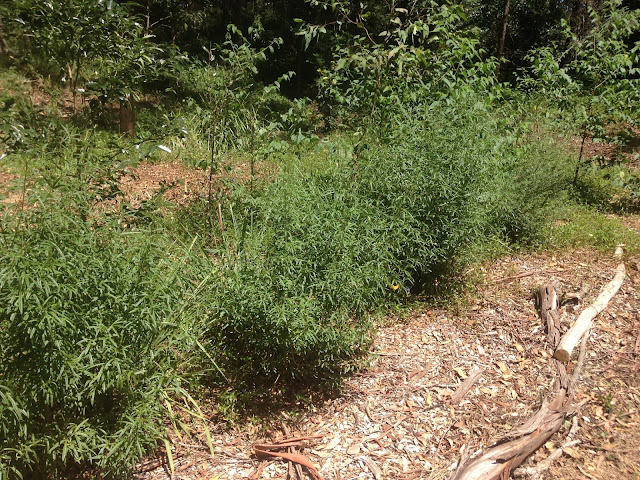Adapted to thrive in this region
Local native plants have evolved in this region over many millions of years and are optimally adapted to growing here. This means they often need less care and attention than introduced species in order to thrive and look great. You shouldn't have to buy special soil or fertiliser, or water much except when plants are young. So choosing them can save you time and money.
 |
| A row of Sandfly Zieria (Zieria smithii), backed by young trees, flourishing in a park in Keiraville. |
Attract native birds and animals
Growing local plants will attract native birds and animals to your garden. Some birds, such as many of the parrot species, love eating the seeds of local eucalypts. Many birds take nectar from flowers, and others snack on insects. Lizards and frogs often hang out in vegetation near ponds or damp, boggy areas. A garden that contains a diversity of local plant species, at all layers from ground cover to canopy, will provide food, shelter and nesting material for fauna, and many hours of critter-spotting for you.
 |
| This New Holland Honeyeater feeds on the nectar from local flowers, such as this Coast Banksia (B. integrifolia). Image by Peter Butler. All rights reserved. |
Support local ecosystems
Our local native plants have evolved in complex relationships with each other, with native fauna and with other organisms such as fungi. The more local species you have in your garden, the better they can sustain these relationships and the better each individual plant will tend to do. Insects may eat leaves or roots, but might also help decompose rotting leaf matter, and many eat other insects and in turn serve as food for birds. Grey-headed Flying-foxes are top pollinators of many local trees, and without these big bats some of those species might struggle to survive. Growing local natives in your garden helps sustain this complex web of life - the more local you plant, the better!
Avoid use of weedy or invasive species
The flipside of growing local plants to support local ecosystems is less use of introduced species that are, or may become, weedy and invasive. Avoiding potentially invasive plants also avoids the work you'd have to do if they run wild in your own garden, and protects nearby natural areas from their ill effects too. The more local the better; many plants sold as 'native' are actually native to other parts of Australia, and some can be just as weedy here as species from other parts of the world.
Help maintain and restore wildlife corridors
With so much of the region's land in private hands and developed for human uses, our own gardens are some of the remaining places where there is potential to increase native plantings and help link up the increasingly isolated patches of remnant vegetation. Wildlife corridors protect native fauna and give them space to survive and thrive; where intact corridors are no longer present, we can help restore them by adding local native plants to land we manage, and creating 'stepping stones' between larger natural areas. This is known as adding 'connectivity.' Anyone with a bit of space in their garden can do it!
Protect local genetic diversity
 |
| Red Cedar growing in Corrimal. But is it a local Red Cedar? Image by Keith Horton. All rights reserved. |
When we're thinking about which plants to put in our gardens, the question of where the plants come from really matters. Just as not all 'native plants' are local natives (i.e. indigenous to this area), some local native plants are more local than others.
What! Why? Because plants, like other species, have genetic diversity within species as well as across species. So, to use examples, species such as Austral Indigo (Indigofera australis) and Red Cedar (Toona australis) have a wide distribution around Australia. But the plants of these species that occur locally are part of local populations that have evolved in this particular context, and that have genetic adaptations to match. Coastal Rosemary or Red Cedar plants grown from seeds or cuttings from, say, Queensland would have different genetics from plants grown from local seeds or cuttings. And growing plants here that originated elsewhere has the potential to 'mess up' the genetic diversity of local populations.
In short, it's best to buy plants that are grown from locally collected seed or cuttings over plants that aren't, or plants where you don't know. That's why the Growing Illawarra Natives website recommends nurseries that stock local provenance plants (i.e. plants grown from local populations of the relevant species). Think of it as like buying a single origin coffee or a bottle of champagne that actually comes from the Champagne region in France; it's sometimes hard to tell the difference from other products, but ultimately it's worth it!
It's a very complex topic and it deserves its own post - coming up!!
 |
| Austral Indigo grown from locally sourced seeds and planted out in a bush revegetation project in Coledale. Truly the 'champagne' plant option! |








No comments
Post a Comment